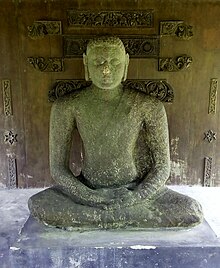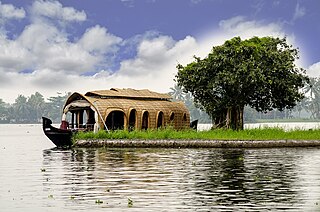
Alappuzha district, is one of the 14 districts in the Indian state of Kerala. It was formed as Alleppey district on 17 August 1957, the name of the district being changed to Alappuzha in 1990. Alappuzha is the smallest district of Kerala. Alleppey town, the district headquarters, was renamed Alappuzha in 2012, even though the anglicised name is still commonly used to describe the town as well as the district.
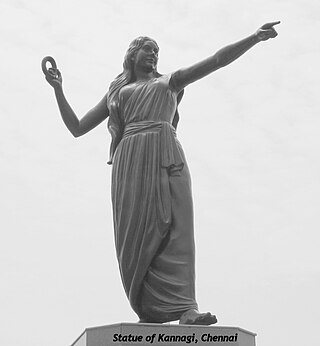
Kannagi, sometimes spelled Kannaki, is a legendary Tamil woman who forms the central character of the Tamil epic Cilappatikaram. Kannagi is described as a chaste woman who stays with her husband despite his adultery, their attempt to rebuild their marriage after her unrepentant husband had lost everything, how he is framed then punished without the due checks and processes of justice. Kannagi proves and protests the injustice, then curses the king and city of Madurai leading to the death of the unjust Pandyan King of Madurai, who had wrongfully put her husband Kovalan to death. The society that had made her suffer, suffers in retribution as the city Madurai is burnt to the ground because of her curse. In Tamil folklore, Kannagi has been deified as the symbol – sometimes as goddess – of chastity, with sculptures or reliefs in Hindu temples iconographically reminding the visitor of her breaking her anklet or tearing her bleeding breast and throwing it at the city.

Bhadrakali is a Hindu goddess. She is considered to be the auspicious and fortunate form of Adi Shakti who protects the good, known as bhadra.
Odanad was a feudal state in late medieval Kerala. It was established in the 11th century, and disestablished in 1746 when it became part of Travancore after Venad King Marthanda Varma's northern expedition. The last king of Odanad was King Kotha Varma. At the time of its dissolution, it was composed of the present-day taluks of Mavelikkara, Karthikapally, Chenganur in the Alappuzha district and Karunagapally in the Kollam district. In the 15th century, the capital of Odanad was moved from Kandiyoor-Muttom, Mavelikkara to Eruva and Krishnapuram, near Kayamkulam, which led to the state being called Kayamkulam. After this shift, Kayamkulam became the commercial centre of Odanad, while Mavelikkara remained its cultural centre. Odanad was controlled by Nair lords, among whom the ruler of Kayamkulam was the most prominent.

Achankovil is a 128 km (80 mi) long west flowing river in Kerala, India. It flows through the districts of Kollam, Pathanamthitta and Alappuzha. The river drains vast tract of fertile plains of Upper Kuttanad in the Alappuzha and Pathanamthitta districts. It also sustains numerous urban settlements along its course such as Konni, Pathanamthitta, Pandalam and Mavelikkara.

Bhagavatī, is an Indian epithet of Sanskrit origin, used as an honorific title for goddesses in Hinduism and Buddhism. In Hinduism, it is primarily used to address the goddesses Durga and Lakshmi. In Buddhism, it is used to refer to several Mahayana Buddhist female deities, like Cundā.
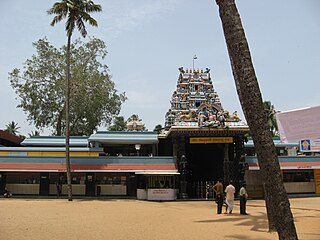
The Attukal Bhagavathy Temple is a Hindu religious shrine at Attukal in Kerala, India. Goddess Bhadrakali (Kannaki), mounted over 'vethala', is the main deity in this temple. Bhadrakali, a form of Mahakali, who killed the demon king Daruka, believed to be born from the third eye of lord Shiva. 'Bhadra' means good and 'Kali' means goddess of time. So Bhadrakali is considered as the goddess of prosperity and salvation. Goddess 'Attukal bhagavathy', itself is the supreme mother 'Bhadrakali', the goddess of power and courage and the fierce form of Devi Aadiparashakti. She is often referred as Kanyavu or Kannaki, the heroine of Ilanko Adikal's 'Silapathikaaram'. The temple is renowned for the annual Attukal Pongal festival, in which over three million women participate. A festival that has figured in the Guinness Book of World Records for being the single largest gathering of women for a religious activity, the Attukal Pongala continues to draw millions of women with each passing year. Attukal Temple is situated near the heart of the city, 2 kilometres away from Sree Padmanabhaswamy Temple, East Fort in Thiruvananthapuram. Devotees believe that all of their wishes will be fulfilled by the goddess, provide prosperity and can attain salvation. Attukal devi is often worshipped in 3 forms such as Maha Saraswati, Maha Lakshmi and Mahakali/ Parvathy.

Chettikulangara Sree Bhagavathi temple is one of the most renowned Hindu temples in Kerala. Main deity is Sree Bhadrakali. The temple is located at Chettikulangara in Mavelikkara taluk of Alappuzha district in the Indian state of Kerala. The temple is situated about 4 kilometres (2.5 mi) west of Mavelikkara town, 7 kilometres (4.3 mi) north of Kayamkulam city on SH6. Bhadrakali, is an incarnation of supreme mother Shakthi devi, born from the third eye of Lord Shiva, to kill the demon king Daruka. 'Bhadra' means good and 'Kali' means goddess of time. So Bhadrakali is worshipped for prosperity and salvation. Devi is considered as the creator, protector, destructor, nature, power and Kundalini shakthi. Chettikulangara is located near Kayamkulam city.
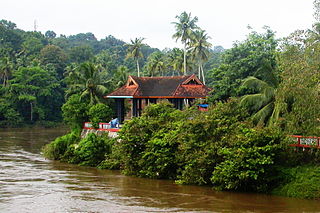
Thazhoor Bhagavathy Kshetram is a 300-year-old Hindu temple on the banks of the Achankovil river in Vazhamuttom, Pathanamthitta District in Kerala. The Devi (goddess) is the main deity here. The centuries-old temple was fully reconstructed in 2020.
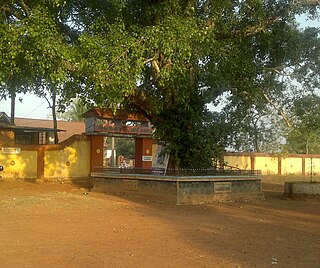
Kizhakkekallada, also known as East Kallada, is a large village in the Kollam district in the state of Kerala, India. It is located about 20 kilometres (12 mi) northeast of Kollam.
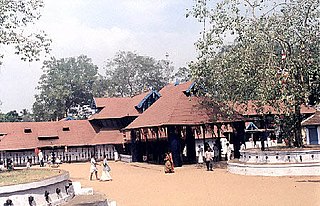
Sree Kurumba Bhagavati Temple is a Hindu temple at Kodungallur, Thrissur District, Kerala state, India. It is dedicated to the goddess Bhadrakali, a form of Mahakali or simply Durga or Aadi Parashakthi worshipped and significantly revered in Kerala. The goddess is known also by the names "Sri Kurumba"". This temple is the head of 64 Bhadrakali temples in Kerala. This Mahakali temple is one of the oldest functioning temples in India. This is attested by numerous Tamil poems and inscriptions of different times. The goddess of the temple represents the goddess in her fierce ('ugra') form, facing North, featuring eight hands with various attributes. One is holding the head of the demon king Daruka, another a sickle-shaped sword, next an anklet, another a bell, among others. Routine worship at the temple every day at 03:00 and ends at 21:00 local time.
Hinduism, Islam and Christianity are the prominent religions in Kollam district. As per the Census 2011, out of the total population of 2,635,375 persons, 64.42% follow Hinduism, 19.30% follow Islam and 16.00% follow Christianity. Other religions comprise 0.04%, while 0.25% did not state any religion.
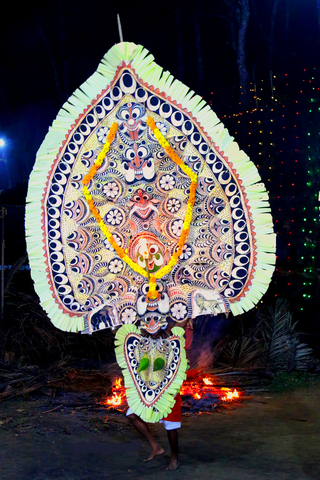
Padayani, also known Padeni, is a traditional folk dance and a ritual art from the central portion of the Indian state of Kerala. A ceremonial dance involving masks, it is an ancient ritual performed in Bhagavati temples. The dance is performed in honor of Bhadrakaali. Meaning, a 'row of warriors', Padayani is an art form that blends all music, dance, theatre, satire, facial masks, and paintings. It is part of worship of Bhadrakali and is staged in temples dedicated to the goddess from mid-December to mid-May. Padayani is unique to central Travancore, comprising the Pathanamthitta and Kottayam districts of Kerala. It is also performed in adjoining regions of Kollam, Alappuzha districts.

Kandiyoor Sree Mahadeva Temple is an ancient Shiva temple situated in Kandiyoor near Mavelikkara on the banks of Achankovil river. Kandiyoor was once the capital of the Odanadu kingdom. The temple and region are related to the history of ancient Buddhism in Kerala. Mattom Sree Mahadeva Temple also known as is 1 kilometre (0.62 mi) west of Mavelikara town north of State Highway 6. It is spread across an area of 7.5 acres (3.0 ha).
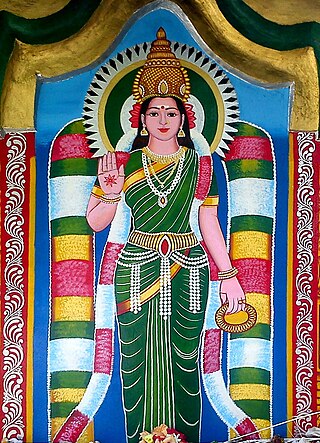
Kannaki Amman is the deified form of Kannagi, the heroine of the Tamil epic Cilappatikāram. She is primarily worshipped in Sri Lanka and Kerala, and in a minor way in few parts of Tamil Nadu. As a goddess of chastity, she is venerated by Indian Tamils and Malayalis, Sri Lankan Tamil Shaivites, and also by the Sinhalese Buddhists as Pattini Amma. In regional Hindu tradition, her tale is interpreted as the story of Durga demanding justice after the death of her husband, Kovalan, who is identified as a form of Shiva.

Parumala Valiya Panayannarkavu Devi Temple is an ancient Hindu temple dedicated to Sri Badrakali and Lord Shiva, situated on the banks of the Pampa river at Parumala of Pathanamthitta District in Kerala state in India. The Panaynararkavu Temple is one of the three most important Bhadrakali temples in Kerala. Thirumandhamkunnu Temple in Malabar, Kodungallur Temple in Cochin and Panayannarkavu Temple in Travancore is almost equally important. References to this temple are found in Aithihyamala of Kottarathil Sankunni and Unnuneeli Sandesam, the classics of Malayalam Literature. According to folklore, sage Parashurama has installed the idol of Lord Shiva and devi idol installed by sage Durvasa and Narada in the Treta Yuga. The temple is a part of the 108 famous Shiva temples in Kerala.
Although Buddhism in Kerala has almost disappeared, historians say that in ancient times Kerala had a strong position and its cultural influence can still be seen in the people of Kerala. It is believed that Buddhism reached Kerala in its infancy. There is historical evidence that Buddhist monks came to Kerala in the 6th century BC.

Vasoorimala is a female deity worshiped in many parts of Kerala and Kodagu region of Karnataka. She is worshipped as an Upa Devata (sub-deity) in Bhadrakali or Shiva temples. Vasoorimala is believed to be a deity that prevents contagious diseases like smallpox, chickenpox, and measles. In North Kerala, Vasoorimala is worshipped and performed as Vasoorimala Theyyam. According to myths, Manodari, wife of Asura named Darikan was later named as Vasoorimala.

Sri Vairankode Bhagavathy Temple is a Bhadrakali shrine located in the town of Vairankode, Malappuram, Kerala The presiding deity is goddess Bhadra Kaali, a form of Lord Rama and Vishnu Deva. It's believed that the sister of Kodungallur Bhagavathy, Sree Vairankode Bhagavathy Temple is one of oldest Bhadrakaali temples in Kerala.

![Broken Karumadikuttan Buddha statue krumaattikkutttt[?] prtim.jpg](http://upload.wikimedia.org/wikipedia/commons/thumb/1/14/%E0%B4%95%E0%B4%B0%E0%B5%81%E0%B4%AE%E0%B4%BE%E0%B4%9F%E0%B4%BF%E0%B4%95%E0%B5%8D%E0%B4%95%E0%B5%81%E0%B4%9F%E0%B5%8D%E0%B4%9F%E0%B5%BB_%E0%B4%AA%E0%B5%8D%E0%B4%B0%E0%B4%A4%E0%B4%BF%E0%B4%AE.jpg/220px-%E0%B4%95%E0%B4%B0%E0%B5%81%E0%B4%AE%E0%B4%BE%E0%B4%9F%E0%B4%BF%E0%B4%95%E0%B5%8D%E0%B4%95%E0%B5%81%E0%B4%9F%E0%B5%8D%E0%B4%9F%E0%B5%BB_%E0%B4%AA%E0%B5%8D%E0%B4%B0%E0%B4%A4%E0%B4%BF%E0%B4%AE.jpg)


